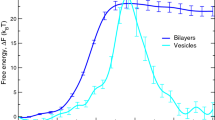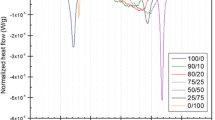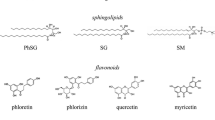Abstract
The temperature-induced budding of POPC–cardiolipin–cholesterol, POPC–POPS–cholesterol and POPC–POPG–cholesterol giant lipid vesicles in the presence of β2-glycoprotein I (β2-GPI) in the outer solution was studied experimentally and theoretically. The observed budding transition of vesicles was continuous which can be explained by taking into account the orientational ordering and direct interactions between oriented lipids. The attachment of positively charged β2-GPI to the negatively charged outer surface of POPC–cardiolipin–cholesterol, POPC–POPS–cholesterol and POPC–POPG–cholesterol giant vesicles caused coalescence of the spheroidal membrane bud with the parent vesicle before the bud could detach from the parent vesicle, i.e. vesiculate. Theoretically, the protein-mediated attraction between the membrane of a bud and the parent membrane was described as an interaction between two electric double layers. It was shown that the specific spatial distribution of charge within β2-GPI molecules attached to the negatively charged membrane surface may explain the observed attraction between like-charged membrane surfaces.









Similar content being viewed by others
References
Ambrožič A, Čučnik S, Tomšič M, Urbanija J, Lokar M, Babnik B, Rozman B, Iglič A, Kralj-Iglič V (2006) Interaction of giant phospholipid vesicles containing cardiolipin and cholesterol with ß2-glycoprotein-I and anti-ß2-glycoprotein-I antibodies. Autoimmunity Rev 6:10–15
Angelova MI, Soleau S, Meleard Ph, Faucon JF, Bothorel P (1992) Preparation of giant vesicles by external AC electric fields: kinetics and applications. Prog Colloid Polym Sci 89:127–131
Asherson RA, Khamashta MA, Ordi-Ros J, Derksen RH, Machin SJ, Barquinero J, Outt HH, Harris EN, Vilardell-Torres M, Hughes GR (1989) The “primary” antiphospholipid syndrome: major clinical and serological features. Medicine (Baltimore) 68:366–374
Balasubramanian K, Schroit AJ (1998) Characterization of phosphatidylserine-dependent beta2-glycoprotein I macriphage interactions: implications for apoptotic cell clearance by phagocytes. J Biol Chem 273:29272–29277
Bevers EM, Janssen MO, Comfurius P, Balasubramanian K, Schroit AJ, Zwaal RFA, Willems GM (2005) Quantitative determination of the binding of ß2- glycoprotein I and prothrombin to phosphatidylserine-exposing blood platelets. Biochem J 386:271–279
Božič B, Kralj-Iglič V, Svetina S (2006) Coupling between vesicle shape and lateral distribution of mobile membrane inclusions. Phys Rev E 73:041915/1–11
Bouma B, de Groot PG, van den Elsen JMH, Ravelli RBG, Schouten A, Simmelink JA, Derksen MJA, Kroon J, Gros P (1999) Adhesion mechanism of human β2-glycoprotein I to phospholipids based on its crystal structure. EMBO J 18:5166–5174
Brighton TA, Hogg PJ, Dai YP, Murray BH, Chong BH, Chesterman CN (1996) Beta 2-glycoprotein I in thrombosis: evidence for a role as a natural anticoagulant. Br J Haematol 93:185–194
Deguchi H, Fernandez JA, Hackeng TM, Banka CL, Griffin JH (2000) Cardiolipin is a normal component of human plasma: a lipoproteins. Proc Natl Acad Sci (USA) 97:1743–1748
Diamant M, Tushuizen ME, Sturk A, Nieuwland R (2004) Cellular microparticles: new players in the field of vascular disease? Eur J Clin Invest 34:392–401
Dignat-George F, Camoin-Jau L, Sabatier F, Arnoux D, Anfosso F, Bardin N, Veit V, Combes V, Gentile S, Moal S, Sanmarco M, Sampol J (2004) Endothelial microparticles: a potential contribution to the thrombotic complications of the antiphospholipid syndrome. Thromb Haemost 91:667–673
Distler JHW, Pisetsky DS, Huber LC, Kalden JR, Gay S, Distler O (2005) Microparticles as regulators in inflammation. Arthritis Rheum 52:3337–3348
Evans EA, Skalak R (1980) Mechanics and thermodynamics of biomembranes. CRC Press, Boca Raton
Evans DF, Wennerström H (1999) The colloidal domain: where physics, chemistry, biology and technology meet, 2nd edn. Wiley, New York
Farsad K, De Camilli P (2003) Mechanisms of membrane deformation. Curr Opin Cell Biol 15:372–381
Gamsjaeger R, Johs A, Gries A, Gruber HJ, Romamnin C, Prassl R, Hinterdorfer P (2005) Membrane binding of β2-glycoprotein I can be described by a two-state reaction model: an atomic force microscopy and surface plasmon resonance study. Biochem J 389:665–673
Greenwalt TJ (2006) The how and why of exocytic vesicles. Transfusion 46:143–152
Hägerstrand H, Mrowczynska L, Salzer U, Prohaska R, Michelsen KA, Kralj-Iglič V, Iglič A (2006) Curvature dependent lateral distribution of raft markers in the human erythrocyte membrane. Mol Membr Biol 23:277–288
Hagihara Y, Goto Y, Kato H, Yoshimura T (1995) Role of the N- and C-terminal domains of bovine beta 2-glycoprotein I in its interaction with cardiolipin. J Biochem (Tokyo) 118:129–136
Helfrich W (1973) Elastic properties of lipid bilayers: theory and possible experiments. Z Naturforsch 28c:693–703
Helfrich W (1974) Blocked lipid exchange in bilayers and its possible influence on the shape of vesicles. Z Naturforsch 29c:510–515
Helfrich W (1995) Tension-induced mutual adhesion and a conjectured superstructure of lipid membranes. In: Lipowsky R, Sackmann E (eds) Structure and dynamics of membranes. Elsevier, Amsterdam, pp 691–721
Holopainen JM, Angelova MI, Kinnunen PKJ (2000) Vectorial budding of vesicles by asymmetrical enzymatic formation of ceramide in giant liposomes. Biophys J 78:830–838
Holopainen JM, Angelova MI, Söderlund T, Kinnunen PKJ (2002) Macroscopic consequences of the action of phospholipase C on giant unilamellar liposomes. Biophys J 83:932–943
Huttner WB, Zimmerberg J (2001) Implications of lipid microdomains for membrane curvature, buddding and fission. Curr Opin Cell Biol 13:478–484
Hwang WC, Waugh RA (1997) Energy of dissociation of lipid bilayer from the membrane skeleton of red blood cells. Biophys J 72:2669–2678
Iglič A, Kralj-Iglič V, Majhenc J (1999) Cylindrical shapes of closed lipid bilayer structures correspond to an extreme area difference between the two monolayers of the bilayer. J Biomech 32:1343–1347
Iglič A, Kralj-Iglič V (2006) Budding of liposomes: role of intrinsic shape of membrane constituents. In: Leitmannova Liu A (eds) Advances in planar lipid bilayers and liposomes. Elsevier, Amsterdam, pp 253–279. http://www.sciencedirect.com/science/bookseries/15544516
Iglič A, Babnik B, Gimsa U, Kralj-Iglič V (2006) On the role of membrane anisotropy in the beading transition of undulated tubular membrane structures. J Phys A Math Gen 38:8527–8536
Iglič A, Babnik B, Fošnarič M, Hägerstrand H, Kralj-Iglič V (2007a) On the role of anisotropy of membrane constituents in formation of a membrane neck during budding of multicomponent membrane. J Biomech 40:579–585
Iglič A, Lokar M, Babnik B, Slivnik T, Veranič P, Hägerstrand H, Kralj-Iglič V (2007b) Possible role of flexible red blood cell membrane nanodomains in the growth and stability of membrane nanotubes. Blood Cells Mol Dis 39:14–23
Israelachvili JN (1997) Intermolecular and surface forces. Academic Press, London
Käs J, Sackmann E (1991) Shape transitions and shape stability of giant phospholipid vesicles in pure water induced by area-to-volume change. Biophys J 60:825–844
Khalil MF, Wagner WD, Goldberg IJ (2006) Molecular interactions leading to lipoprotein retention and the initiation of atheriosclerosis. Arterioscler Thromb Vasc Biol 24:2211–2218
Kralj-Iglič V, Iglič A (1996) A simple statistical mechanical approach to the free energy of the electric double layer including excluded volume effect. J Phys II (France) 6:477–491
Kralj-Iglič V, Iglič A, Gomišček G, Sevšek F, Arrigler V, Hägerstrand H (2002) Microtubes and nanotubes of a phospholipid bilayer membrane. J Phys A Math Gen 35:1533–1549
Kralj-Iglič V, Babnik B, Gauger DR, May S, Iglič A (2006) Quadrupolar ordering of phospholipid molecules in narrow necks of phospholipid vesicles. J Stat Phys 125:727–752
Laradji M, Kumar PBS (2004) Dynamics of domain growth in self-assembled fluid vesicles. Phys Rev Lett 93:198105/1–198105/4
Lipowsky R (1991) The conformation of membranes. Nature 349:475–481
Masuda M, Takeda S, Sone M, Ohki T, Mori H, Kamioka Y, Mochizuki N (2006) Endophilin BAR domain drives membrane curvature by two newly identified structure-based mechanisms. EMBO J 25:2889–2897
McMahon HT, Gallop JL (2005) Membrane curvature and mechanisms of dynamic cell membrane remodelling. Nature 438:590–596
Miao L, Seifert U, Wortis M, Döbereiner HG (1994), Budding transitions of fluid-bilayer vesicles: effect of area difference elasticity. Phys Rev E 49:5389–5407
Miyakis S, Giannakopoulos B, Krilis SA (2004) Beta 2 glycoprotein I-function in health and disease. Thromb Res 114:335–346
Miyakis S, Lockshin MD, Atsumi T, Branch DW, Brey RL, Cervera R, Derksen RH, De Groot PG, Koike T, Meroni PL, Shoenfeld Y, Tincani A, Vlachoyiannopolous PG, Krilis SA (2006) International consensus statement on an update of the classification criteria for definite antiphospholipid syndrome (APS). J Thromb Haemost 4:295–306
Polz E, Kostner GM (1979) The binding of β2-glycoprotein-I to human serum lipoproteins. FEBS Lett 102:183–186
Raphael RM, Waugh RE (1996) Accelerated interleaflet transport of phosphatidylcholine molecules in membranes under deformation. Biophys J 71:1374–1388
Roubey RAS (2000) Antiphospholipid syndrome: antibodies and antigenes. Curr Opin Hematol 7:316–320
Sackmann E (1994) Membrane bending energy concept of vesicle and cell shapes and shape transitions. FEBS Lett 346:3–16
Schousboe I (1979) Purification, characterization and indentification of an agglutinin in human serum. Biochim Biophys Acta 579:396–408
Schwarzenbacher R, Zeth K, Diederichs K, Gries A, Kostner GM, Laggner P, Prassl R (1999) Crystal structure of human β2-glycoprotein I: implications for phospholipid binding and the antiphospholipid syndrome. EMBO J 18:6228–6239
Sens P, Gov N (2007) Force balance and membrane shedding at the red-blood-cell surface. Phys Rev Lett 98:018102/1–018102/4
Sens P, Turner MS (2004) Theoretical model for the formation of caveolae and similar membrane invaginations. Biophys J 86:2049–2057
Stokke BT, Mikkelsen A, Elgsaeter A (1986) The human erythrocyte membrane skeleton may be an ionic gel. Eur Biophys J 13:203–218
Urbanija J, Tomšič N, Lokar M, Ambrožič A, Čučnik S, Rozman B, Kandušer M, Iglič A, Kralj-Iglič V (2007) Coalescence of phospholipid membranes as a possible origin of anticoagulant effect of serum proteins. Chem Phys Lipids 150:49–57
Wang F, Xia XF, Sui SF (2002) Human apolipoprotein H may have various orientations when attached to lipid layer. Biophys J 83:985–993
Willems GM, Janssen MP, Pelsers MAL, Comfurius P, Galli M, Zwaal RFA, Bevers EM (1996) Role of divalency in the high-affinity binding of anticardiolipin antibody-β2-glycoprotein I complex to lipid membranes. Biochemistry 35:13833–13842
Acknowledgments
This work was supported by ARRS grants J3-9219-0381-06 and P2-0232-1538.
Author information
Authors and Affiliations
Corresponding author
Additional information
Regional Biophysics Conference of the National Biophysical Societies of Austria, Croatia, Hungary, Italy, Serbia, and Slovenia.
Rights and permissions
About this article
Cite this article
Urbanija, J., Babnik, B., Frank, M. et al. Attachment of β2-glycoprotein I to negatively charged liposomes may prevent the release of daughter vesicles from the parent membrane. Eur Biophys J 37, 1085–1095 (2008). https://doi.org/10.1007/s00249-007-0252-1
Received:
Revised:
Accepted:
Published:
Issue Date:
DOI: https://doi.org/10.1007/s00249-007-0252-1




